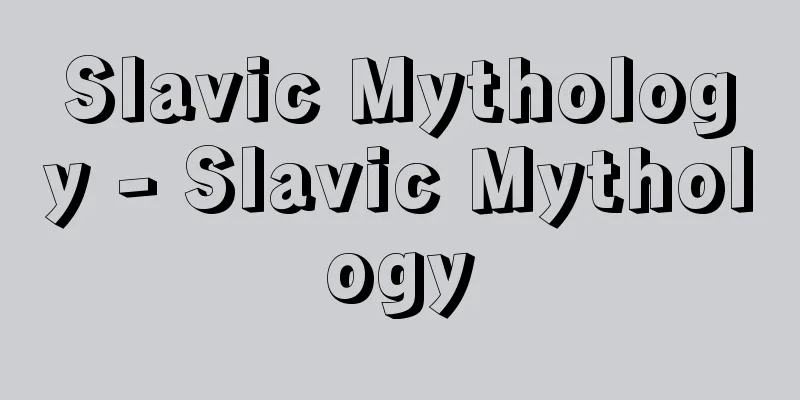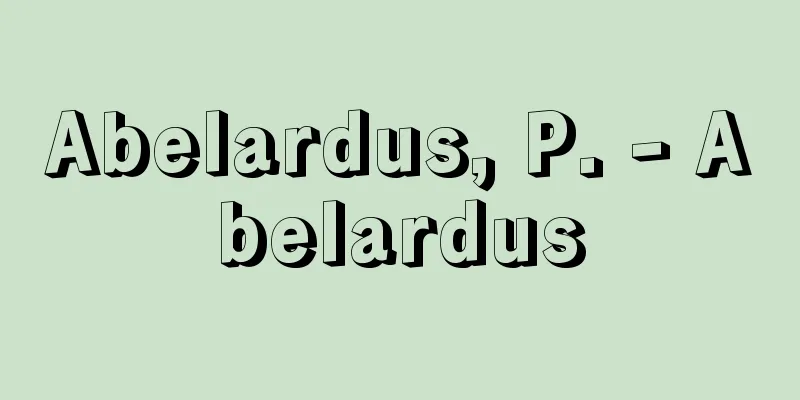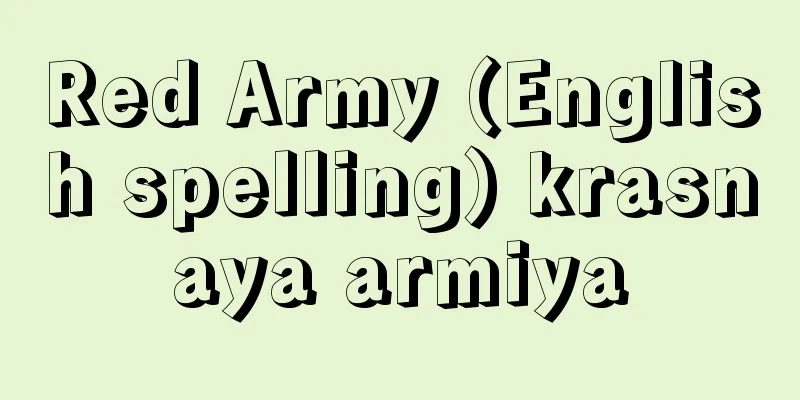Slavic Mythology - Slavic Mythology

|
The totality of mythology that is thought to have existed among the Slavic peoples before they differentiated. The Slavic peoples suppressed their belief in pagan gods when they officially accepted Christianity (9th-10th centuries), so there are no written sources that convey the whole picture of their mythology. Therefore, what is called Slavic mythology is merely a reconstruction of fragmentary information that appears in medieval historical documents such as chronicles, and existing folklore materials. However, lower deities (such as spirits) that were closely connected to the lives of the people survive in folk beliefs that the church was unable to completely suppress. Based on the results of research into the mythology of the Indo-European peoples, it is believed that the supreme deities associated with the public rituals of the pre-differentiation Slavic peoples were Pärnü (Russian: Perun) and Veles (Russian: same), the former representing warriors and the latter embodying productive activities dealing with nature. Furthermore, it is believed that a goddess was added to the supreme deity, but her name has not been passed down. Pärnü is a thunder god living in the sky, and for some reason begins a battle with Veles, who lives on earth. Veles hides under trees and stones, and transforms into humans and livestock to escape, but she is no match for Pärnü, the thunder god who can smash even large trees and rocks. Heavy rains fall with Pärnü's victory, which brings about ripe crops. However, Pärnü was not a deity worshipped by the people, but merely the object of the rulers' rituals. This is also evident from the chronicle's account that Prince Vladimir of Kievan Rus embraced Christianity in 988 and threw a statue of Perun into the Dnieper River. Other high-ranking deities that make up the Slavic pantheon include the ancient Russian fire god Svarog (whose name in the South Slavic people is unclear), the sun god Dazhbog (the name in the East Slavic people) or Dabog (the name in the South Slavic people). The next level includes deities associated with agriculture and ancestor worship, such as the East Slavic livestock god Mokosh, and Rhod and Tyur, meaning "birth" or "father". In addition, a series of abstract nouns such as "death", "fate", and "judgment" formed a separate system as goddesses, but despite their abstract nature, they do not seem to have been very highly ranked as deities. However, it is said that the antagonistic relationship between two deities, such as "life and death" and "fire and water", is one of the characteristics of Slavic mythology, and is not limited to these types of deities. Although not deities, the names of mythical heroes such as Kii, Šiček, and Khoriv among the Eastern Slavs, and Cekh, Lyakh, and Klav among the Western Slavs are known, and these were used to explain the origins of place names and ethnic names. The lower-level deities, or spirits, passed down through folklore sources such as folk tales and songs reflect the lives of the Slavic peoples well. Some of them, mainly among the Eastern Slavs, are Domovoi, the house spirit, Kikimora, who is said to be his wife, Bannik, the bath spirit, Obinnik, the granary spirit, Leshii, the forest spirit, and Polevoi, the field spirit, and they were believed to help people's lives if certain rituals were offered to them. Conversely, spirits that harm people include the water spirit Vodjanoi and the water fairy Rusalka (Bila among the Western Slavs), who is said to drown young girls. Slavic mythology as a system was lost with the introduction of Christianity, but some pagan beliefs and customs remained strong, linked to Christian beliefs and rituals. This form is called dual faith (dvoebelye). For example, the attributes of the thunder god Pärnü were linked to the prophet Elijah of the Old Testament, who ascended to heaven on a chariot of fire, and the pagan festival of Kupalo was superimposed on the feast day of John the Baptist to become the festival of Ivan Kupalo. Parts of Slavic mythology were passed down to later generations in the form of such dual faith. [Tatsuya Moriyasu] Source: Shogakukan Encyclopedia Nipponica About Encyclopedia Nipponica Information | Legend |
|
スラブ民族が分化以前に保有していたと考えられる神話の総体。スラブ諸民族は、キリスト教の公式の受容(9~10世紀)とともに、異教の神々への信仰を圧殺したため、神話の全体像を伝える文献資料はまったく存在していない。したがって、スラブ神話といわれるものは、年代記をはじめとする中世の史書、および現存のフォークロア資料に現れる断片的情報を再構成したものにすぎない。ただし、民衆の生活と密接に結び付いた下級の神格(精霊など)は、教会が抑圧しきれなかった民間信仰のなかに生き残っている。 インド・ヨーロッパ諸族神話研究の成果から推定を試みると、分化以前のスラブ民族の間で公的な祭儀と結び付いた最高の神格は、ペルヌ(ロシア語ペルーン)とベレス(ロシア語も同じ)の二神で、前者は戦士を代表し、後者は自然を相手にする生産活動を体現したとされる。さらに、最高の神格に一女神が加わっていたとされるが、その名は伝わっていない。ペルヌは天に住む雷神で、地上に住むベレスとなんらかの原因で闘争を始める。ベレスは木や石の下に隠れ、また人間や家畜に姿を変えて逃走するが、大木や岩をも打ち砕く雷神ペルヌの敵ではなかった。ペルヌの勝利とともに大雨が降り、これが作物に実りをもたらした。しかしペルヌは民衆が崇拝した神格ではなく、支配者の祭儀の対象にすぎなかった。その点は、キエフ・ロシアのウラジーミル公が988年にキリスト教を受け入れ、ペルーンの神像をドニエプル川に投げ捨てたとの年代記の記事からもうかがわれる。 そのほか、スラブ神話のパンテオンを構成する上級の神格として、古代ロシアの火の神スバログ(南スラブ人のもとでの名称ははっきりしない)、太陽神ダジボグ(東スラブ人のもとでの名称)またはダボグ(南スラブ人のもとでの名称)などが知られている。次の段階に属するのは、農耕や祖先崇拝に結び付く神格で、東スラブ人の家畜神モコーシ、さらに「生まれ」または「父祖」を意味するロードとチュールがあげられる。また「死」「運命」「裁き」といった一連の抽象名詞が女神として別の体系をなしていたが、その抽象性にもかかわらず、神格としての地位はそれほど高くなかったらしい。ただこの種の神格に限らず、「生と死」「火と水」といった二つの神格の対立関係がスラブ神話の一特徴をなすといわれている。 神格ではないが、神話上の英雄として東スラブ人のキイ、シチェク、ホリフ、西スラブ人のチェフ、リャフ、クラフなどの名が伝わるが、これらは地名や民族名の起源説明に用いられた。民話や民謡などフォークロア資料によって伝わる下級の神格、すなわち精霊の類は、スラブ民族の生活をよく反映している。東スラブ人を中心にいくつかをあげると、家の精を意味するドモボイ、その妻とされるキキーモラ、風呂場(ふろば)の精バンニク、穀倉の精オビンニク、森の精レシイ、野の精ポレボイなどがあり、これらは、ある種の儀礼が捧(ささ)げられればむしろ人間の生活を助けるものとされた。逆に人間に危害を与える精霊としては、水の精ボジャノイ、若い娘がおぼれてなるといわれる水の妖精(ようせい)ルサルカ(西スラブ人のビラ)などが知られている。 体系としてのスラブ神話はキリスト教の導入とともに失われたが、キリスト教の信仰と祭儀に結び付いて根強く残った異教的信仰と習慣もある。このような形態を二重信仰(ドボエベリエ)とよぶ。たとえば雷神ペルヌの属性は、火の車に乗って昇天したという『旧約聖書』の預言者エリヤと結び付けられ、異教時代のクパロの祭りは、洗礼者ヨハネの祭日に重ねられてイバン・クパロの祭りとなった。スラブ神話の一部は、このような二重信仰の形でも後代に伝えられた。 [森安達也] 出典 小学館 日本大百科全書(ニッポニカ)日本大百科全書(ニッポニカ)について 情報 | 凡例 |
>>: Slavic People's Conference - Slovanský sjezd (English spelling)
Recommend
californium
Cf. Atomic number 98. Group 3 actinide element wi...
Petaurus norfolcensis (English spelling)
...Marsupial [Yoshiharu Imaizumi]. . … *Some of t...
Horn of Africa - The Horn of Africa
Horn of Africa. The eastern part of the African co...
Napier, John
Born 1550 in Merchiston, near Edinburgh [Died] Apr...
Reinforcement learning
A machine learning technique. Instead of correct a...
Yoshisuke Totsugi - Tetsugyokai
A Soto sect monk from the Kamakura period. Born i...
Rosaceae
The custom of offering roses to graves and to the...
Keerthana - Keerthana
...Among these, there exists a singing style that...
Gasterosteus aculeatus aculeatus
…[Isao Hanyu]. … *Some of the terminology that me...
Modern Painters
The major work of British art critic John Ruskin, ...
Jinuo people (English spelling)
One of China's ethnic minorities officially re...
Shodenji Temple
This temple is of the Nanzen-ji school of the Rinz...
Urtica cannabina (English spelling) Urticacannabina
…[Tetsuichi Yahara]. … *Some of the terminology t...
Entrechat (English spelling)
A ballet term. From the Italian intrecciare (to in...
Koda Shell Mound
This is an archaeological site from the early Jomo...









